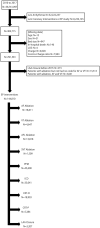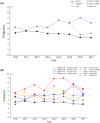Predictors of morbidity and in-hospital mortality following procedure-related cardiac tamponade
- PMID: 37799802
- PMCID: PMC10549810
- DOI: 10.1002/joa3.12911
Predictors of morbidity and in-hospital mortality following procedure-related cardiac tamponade
Abstract
Background: Cardiac tamponade (CT) can be a complication following invasive cardiac procedures. We assessed CT following common cardiac electrophysiology (EP) procedures to facilitate risk prediction of associated morbidity and in-hospital mortality.
Methods: Patients who underwent various EP procedures in the cardiac catheterization lab (ablations and device implantations) were identified using the International Classification of Diseases, Ninth and Tenth Edition, Clinical Modification (ICD-9-CM and ICD-10-CM, respectively) from the Nationwide Inpatient Sample (NIS) database. Patient demographics, presence of comorbidities, CT-related events, and in-hospital death were also abstracted from the NIS database.
Results: The frequency of CT-related events in patients with EP intervention from 2010 to 2017 ranged from 3.4% to 7.0%. In-hospital mortality related to CT-related events was found to be 2.2%. Increasing age was the only predictor of higher mortality in atrial fibrillation (AF) ablation and cardiac resynchronization therapy (CRT) groups (OR [95% CI]: AF ablation = 11.15 [1.70-73.34], p = .01; CRT = 1.41 [1.05-1.90], p = .02).
Conclusions: In the real-world setting, CT-related events in EP procedures were found to be 3.4%-7.0% with in-hospital mortality of 2.2%. Older patients undergoing AF ablation were found to have higher mortality.
Keywords: cardiac tamponade; electrophysiological procedures; mortality.
© 2023 The Authors. Journal of Arrhythmia published by John Wiley & Sons Australia, Ltd on behalf of Japanese Heart Rhythm Society.
Conflict of interest statement
Authors declare no conflict of interests for this article.
Figures


Similar articles
-
Pericardial tamponade in coronary interventions: Morbidity and mortality.Catheter Cardiovasc Interv. 2024 Oct;104(4):707-713. doi: 10.1002/ccd.31213. Epub 2024 Sep 9. Catheter Cardiovasc Interv. 2024. PMID: 39248175
-
In-hospital complications associated with catheter ablation of atrial fibrillation in the United States between 2000 and 2010: analysis of 93 801 procedures.Circulation. 2013 Nov 5;128(19):2104-12. doi: 10.1161/CIRCULATIONAHA.113.003862. Epub 2013 Sep 23. Circulation. 2013. PMID: 24061087
-
Temporal trends of in-hospital complications associated with catheter ablation of atrial fibrillation in the United States: An update from Nationwide Inpatient Sample database (2011-2014).J Cardiovasc Electrophysiol. 2018 May;29(5):715-724. doi: 10.1111/jce.13471. Epub 2018 Mar 30. J Cardiovasc Electrophysiol. 2018. PMID: 29478273
-
Cardiac Resynchronization in Patients with Atrial Fibrillation.J Atr Fibrillation. 2015 Dec 31;8(4):1383. doi: 10.4022/jafib.1383. eCollection 2015 Dec. J Atr Fibrillation. 2015. PMID: 27957235 Free PMC article. Review.
-
Utility of CT and MRI in Cardiac Electrophysiology.Radiographics. 2024 Sep;44(9):e230222. doi: 10.1148/rg.230222. Radiographics. 2024. PMID: 39115996 Review.
Cited by
-
Trends in mortality among the geriatric population undergoing Surgical aortic valve replacement (SAVR) and potential racial disparities: a 20-year perspective via the National (Nationwide) Inpatient Sample.J Geriatr Cardiol. 2024 Jul 28;21(7):716-722. doi: 10.26599/1671-5411.2024.07.002. J Geriatr Cardiol. 2024. PMID: 39183953 Free PMC article.
-
Factors associated with procedure-related cardiac tamponade.J Arrhythm. 2023 Oct 11;39(6):1003. doi: 10.1002/joa3.12941. eCollection 2023 Dec. J Arrhythm. 2023. PMID: 38045459 Free PMC article. No abstract available.
-
Intra-pericardial thrombin injection in iatrogenic cardiac tamponade: a case report.Egypt Heart J. 2024 Feb 26;76(1):28. doi: 10.1186/s43044-024-00459-5. Egypt Heart J. 2024. PMID: 38407742 Free PMC article.
-
Unmasking the cannabis paradox: in-hospital outcomes of cannabis users admitted with acute myocardial infarction over a 20-year period in the United States.Arch Med Sci Atheroscler Dis. 2024 Jun 22;9:e137-e146. doi: 10.5114/amsad/189731. eCollection 2024. Arch Med Sci Atheroscler Dis. 2024. PMID: 39086618 Free PMC article.
-
Response to letter to editor, re-predictors of morbidity and in-hospital mortality following procedure-related cardiac tamponade.J Arrhythm. 2024 Jan 3;40(1):200-201. doi: 10.1002/joa3.12983. eCollection 2024 Feb. J Arrhythm. 2024. PMID: 38333392 Free PMC article.
References
-
- Holmes DR, Nishimura R, Fountain R, Turi ZG. Iatrogenic pericardial effusion and tamponade in the percutaneous intracardiac intervention era. J Am Coll Cardiol Intv. 2009;2(8):705–717. - PubMed
-
- Beyls C, Hermida A, Duchateau J, Maury P, Taieb J, Laurent G, et al. Management of acute cardiac tamponade by direct autologous blood transfusion in interventional electrophysiology. J Cardiovasc Electrophysiol. 2019;30(8):1287–1293. - PubMed
-
- Gruberg L, Pinnow E, Flood R, Bonnet Y, Tebeica M, Waksman R, et al. Incidence, management, and outcome of coronary artery perforation during percutaneous coronary intervention. Am J Cardiol. 2000;86(6):680–682. - PubMed
-
- Dippel EJ, Kereiakes DJ, Tramuta DA, Broderick TM, Shimshak TM, Roth EM, et al. Coronary perforation during percutaneous coronary intervention in the era of abciximab platelet glycoprotein IIb/IIIa blockade: an algorithm for percutaneous management. Catheter Cardiovasc Interv. 2001;52(3):279–286. - PubMed
LinkOut - more resources
Full Text Sources
Research Materials
Miscellaneous

